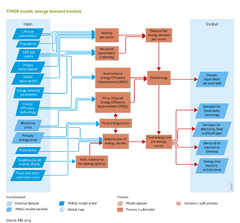Energy demand/Description: Difference between revisions
Jump to navigation
Jump to search
No edit summary |
No edit summary |
||
| Line 27: | Line 27: | ||
===Autonomous Energy Efficiency Increase (AEEI)=== | ===Autonomous Energy Efficiency Increase (AEEI)=== | ||
This is a multiplier used in the generic energy demand module to account for efficiency improvement as a result of technology improvement, independent of prices. In general, current appliances are more efficient than those available in the past. | This is a multiplier used in the generic energy demand module to account for efficiency improvement as a result of technology improvement, independent of prices. In general, current appliances are more efficient than those available in the past. | ||
The autonomous energy efficiency increase for new capital is a fraction (f) of the economic growth rate based on the formulation of Richels et al. ([[Richels et al., 2004|2004]]). The fraction varies between 0.45 and 0.30 (based on literature data) and is assumed to decline with time because the scope for further improvement is assumed to decline. Efficiency improvement is assumed for new capital. Autonomous increase in energy efficiency for the average capital stock is calculated as the weighted average value of the AEEI values of the total in capital stock, using the vintage formulation. In the ''technology-detailed submodules'', the autonomous energy efficiency increase is represented by improvement in individual technologies over time. | The autonomous energy efficiency increase for new capital is a fraction (f) of the economic growth rate based on the formulation of Richels et al. ([[Richels et al., 2004|2004]]). The fraction varies between 0.45 and 0.30 (based on literature data) and is assumed to decline with time because the scope for further improvement is assumed to decline. Efficiency improvement is assumed for new capital. Autonomous increase in energy efficiency for the average capital stock is calculated as the weighted average value of the AEEI values of the total in capital stock, using the vintage formulation. In the ''technology-detailed submodules'', the autonomous energy efficiency increase is represented by improvement in individual technologies over time. | ||
Revision as of 15:17, 22 May 2014
Parts of Energy demand/Description
| Component is implemented in: |
|
| Related IMAGE components |
| Projects/Applications |
| Key publications |
| References |
